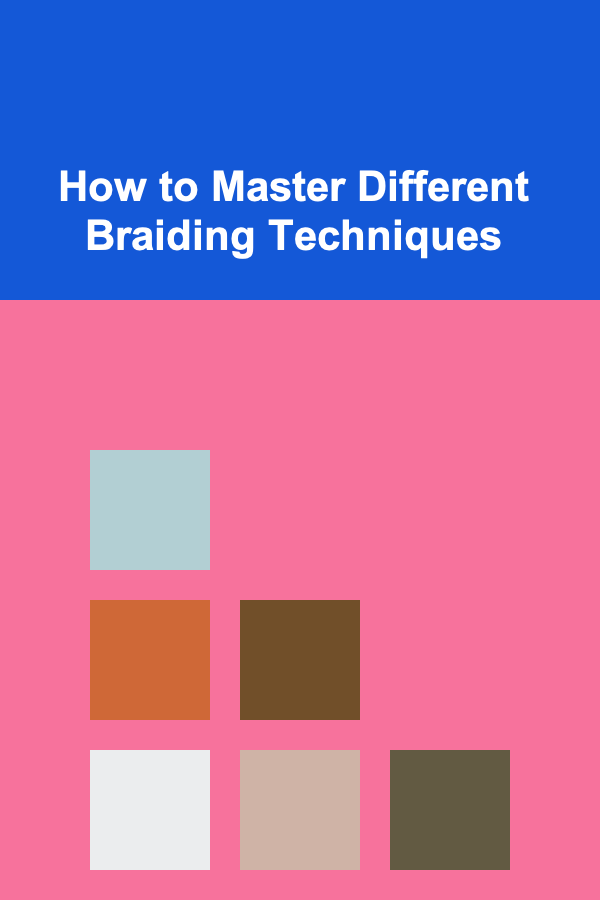
How to Master Different Braiding Techniques
ebook include PDF & Audio bundle (Micro Guide)
$12.99$5.99
Limited Time Offer! Order within the next:

Braiding is one of the oldest and most versatile techniques used in various cultures for creating intricate and functional patterns. Whether for fashion, hairstyles, or crafts, braiding has remained an essential skill passed down through generations. Mastering different braiding techniques can empower individuals to create beautiful, durable, and innovative works, whether it's a stunning braid for a hairstyle or a detailed woven pattern for textiles.
In this guide, we will dive into several popular braiding techniques, offering a comprehensive approach to mastering them, the history behind them, and the skills required. This exploration will also give you insight into how braiding has been used in different cultures and its applications in both fashion and functional design.
Understanding the Basics of Braiding
Before delving into specific techniques, it's important to understand the fundamental principles of braiding. At its core, braiding involves intertwining three or more strands of material in a structured pattern. The most common materials used for braiding include hair, fabric, leather, and even rope or wire. While the specifics of each technique may vary, the basic structure of braids involves the crossing over and under of strands to create interlocking sections.
The three essential elements of any braid are:
- Strands: The individual components that are braided together. In hair braiding, this refers to strands of hair, while in crafts, it could refer to yarn, string, or leather strips.
- Tension: The tightness or looseness of the braid, which directly affects its texture and durability. Proper tension ensures that the braid is uniform and secure.
- Pattern: The repetitive sequence in which the strands are crossed over and under. Different patterns create different braid types, which can be simple or complex.
Understanding how to manipulate these elements is crucial to mastering braiding techniques.
Key Braiding Techniques to Master
1. Three-Strand Braid
The three-strand braid is the most basic and commonly used braiding technique. It's the foundation for more advanced braiding styles, and mastering it will give you the confidence to explore other patterns.
How to Braid:
- Divide your material into three even sections.
- Start by crossing the right section over the middle section. This will make the right section the new middle.
- Next, cross the left section over the new middle section. Continue this pattern, alternating from right to left, until you reach the end of the strands.
- Secure the braid with a tie or band at the end to prevent it from unraveling.
Applications: The three-strand braid is incredibly versatile. It is used in hair, jewelry making, leatherwork, and even in creating ropes. It can be used as a simple hairstyle or as the base for more intricate braids.
2. Four-Strand Braid
The four-strand braid offers more texture and complexity than the three-strand braid. It adds depth and can create an elegant, slightly more intricate appearance.
How to Braid:
- Divide your material into four equal sections.
- Start by crossing the far right section over the second right section. This will bring the far right section to the middle.
- Next, cross the far left section over the second left section. Repeat this alternating pattern, pulling each section over to the middle one at a time.
- Finish the braid by securing it with a tie at the end.
Applications: This braid is often used in crafting to create decorative pieces like belts, bracelets, or keychains. It's also popular in hair braiding, where it creates a more elaborate and voluminous style.
3. French Braid
The French braid is one of the most popular braiding styles for hair. It incorporates additional hair into the braid as it progresses down the head, making it a more intricate and beautiful variation of the traditional three-strand braid.
How to Braid:
- Start at the top of your head and gather three equal sections of hair.
- Cross the right section over the middle section, and then the left section over the new middle section.
- As you continue braiding, begin incorporating small sections of hair into the braid from the left and right sides, adding them to the outer sections as you cross them over.
- Continue until you reach the end, where you can finish with a regular three-strand braid to the tips of your hair.
Applications: The French braid is a popular style for both formal and casual occasions. It's also used in different hair styles such as the French twist or fishtail braid by modifying the basic technique.
4. Fishtail Braid
The fishtail braid is an elegant and intricate braiding technique that creates a braid with a distinct, crisscross pattern. While it appears complex, it's relatively easy to learn with practice.
How to Braid:
- Divide your hair into two equal sections.
- Take a small piece from the outside of the right section and cross it over to the left section.
- Do the same on the left side, crossing a small piece over to the right section.
- Continue alternating sides, each time taking a small section from the outer edges and crossing it over.
- Finish by securing the braid with a tie once you reach the end.
Applications: The fishtail braid is often used for casual yet chic hairstyles, but it's also a favorite for elegant occasions and festivals. Its detailed pattern makes it a showstopper in both hair and textile work.
5. Dutch Braid
The Dutch braid is often referred to as an "inside-out" braid because the strands are crossed under rather than over, creating a raised effect.
How to Braid:
- Start at the top of your head with three sections of hair.
- Cross the right section under the middle section, and then the left section under the new middle section.
- Incorporate additional hair from the sides as you continue braiding down, crossing the strands under as you go.
- Finish with a standard three-strand braid at the end and secure it with a tie.
Applications: The Dutch braid is often used for athletic or active hairstyles, as it keeps the hair tightly in place. It's also used for a more voluminous and bold style compared to the French braid.
6. Ladder Braid
The ladder braid is a creative and visually appealing technique that uses a combination of traditional braiding and looping to create a "ladder" appearance. This style involves the braiding of sections and the incorporation of loops to form intricate patterns.
How to Braid:
- Divide the hair into two sections for the base braid.
- Begin with a basic three-strand braid on one side.
- As you continue the braid, create small loops with the strands from the other side, weaving them into the main braid.
- The loops should be consistent in size, creating a ladder-like effect as you go down the braid.
- Finish by securing the braid with a tie at the end.
Applications: The ladder braid is often used for creative hairstyles, especially for events like parties or performances. It's a great way to add texture and visual interest to a simple braid.
7. Box Braid
Box braids are a form of protective hairstyle where hair is divided into small square-shaped sections, with each section being braided into individual braids. It is often used for hair that is thick and coarse, offering protection while adding a stylish appearance.
How to Braid:
- Divide the hair into square sections using a comb.
- Start braiding each section of hair by dividing it into three parts, and then following the traditional three-strand braiding pattern.
- Add extensions if desired to add length and thickness to the braids.
- Finish each braid by securing the ends with a band.
Applications: Box braids are commonly used in African and African-American communities. They serve as both a protective style for natural hair and a fashionable look for casual or formal events.
8. Herringbone Braid
The herringbone braid is a complex and intricate pattern that uses two sections of hair or material. It is visually striking and can be a unique alternative to the standard braid styles.
How to Braid:
- Divide your hair into two sections.
- Take a small piece from the outer side of the left section and cross it over to the right.
- Do the same for the right section, taking a small piece from the outer edge and crossing it over to the left.
- Continue this alternating pattern, taking smaller sections from the outer edges each time.
- Secure the end once the braid is complete.
Applications: This braid is often used for formal occasions due to its sophisticated appearance. It's also used in jewelry making or leather crafting.
Tips for Mastering Braiding
- Practice Regularly: Like any skill, braiding requires regular practice. Start with simpler braids and work your way up to more complex styles.
- Maintain Consistent Tension: Keeping a consistent tension throughout the braid will ensure a smooth, uniform result.
- Use the Right Tools: Ensure that you use appropriate tools, such as combs, clips, or hair ties, to keep your sections organized and your braids neat.
- Learn from Tutorials: Use online resources, tutorials, and videos to see the braids in action. Sometimes, visual demonstrations help with understanding the intricacies of the technique.
- Be Patient: Braiding, especially more advanced styles, takes time. Don't be discouraged if your first attempts aren't perfect.
Conclusion
Mastering different braiding techniques can be a rewarding and creative pursuit. Whether you are braiding hair, ropes, or fabric, each technique provides a unique opportunity to explore the intersections of design, functionality, and culture. With practice and patience, anyone can become proficient in these techniques, adding a new layer of skill to their craft or hairstyle repertoire. Braiding is not just a skill; it's an art form that has withstood the test of time, evolving into countless variations to suit different needs and aesthetics.

How to Build a Deep Learning-Based Passive Income Business
Read More
How to Create a Home Security Plan for Families with Young Children
Read More
How to Earn Passive Income by Teaching Deep Learning Online
Read More
How to Sell Your Rare Vinyl Records Through Virtual Music Fairs: An Actionable Guide
Read More
How to Set Up a "Homework Help" Corner with Resources
Read More
How to Build a DIY Bioluminescence Kit
Read MoreOther Products

How to Build a Deep Learning-Based Passive Income Business
Read More
How to Create a Home Security Plan for Families with Young Children
Read More
How to Earn Passive Income by Teaching Deep Learning Online
Read More
How to Sell Your Rare Vinyl Records Through Virtual Music Fairs: An Actionable Guide
Read More
How to Set Up a "Homework Help" Corner with Resources
Read More